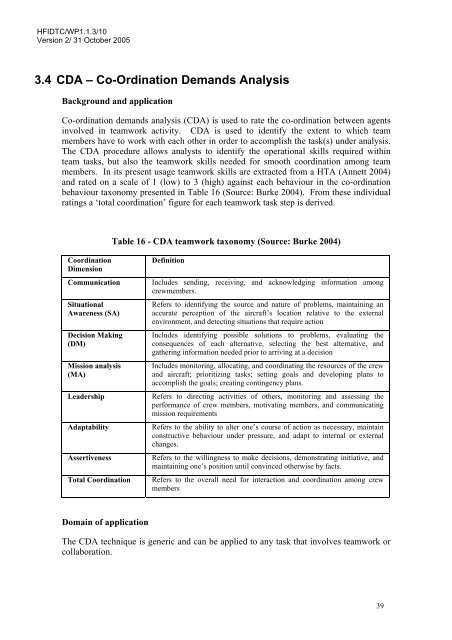A Review of the Event Analysis of Systemic Teamwork Methodology
A Review of the Event Analysis of Systemic Teamwork Methodology
A Review of the Event Analysis of Systemic Teamwork Methodology
- No tags were found...
Create successful ePaper yourself
Turn your PDF publications into a flip-book with our unique Google optimized e-Paper software.
HFIDTC/WP1.1.3/10<br />
Version 2/ 31 October 2005<br />
3.4 CDA – Co-Ordination Demands <strong>Analysis</strong><br />
Background and application<br />
Co-ordination demands analysis (CDA) is used to rate <strong>the</strong> co-ordination between agents<br />
involved in teamwork activity. CDA is used to identify <strong>the</strong> extent to which team<br />
members have to work with each o<strong>the</strong>r in order to accomplish <strong>the</strong> task(s) under analysis.<br />
The CDA procedure allows analysts to identify <strong>the</strong> operational skills required within<br />
team tasks, but also <strong>the</strong> teamwork skills needed for smooth coordination among team<br />
members. In its present usage teamwork skills are extracted from a HTA (Annett 2004)<br />
and rated on a scale <strong>of</strong> 1 (low) to 3 (high) against each behaviour in <strong>the</strong> co-ordination<br />
behaviour taxonomy presented in Table 16 (Source: Burke 2004). From <strong>the</strong>se individual<br />
ratings a ‘total coordination’ figure for each teamwork task step is derived.<br />
Table 16 - CDA teamwork taxonomy (Source: Burke 2004)<br />
Coordination<br />
Dimension<br />
Communication<br />
Situational<br />
Awareness (SA)<br />
Decision Making<br />
(DM)<br />
Mission analysis<br />
(MA)<br />
Leadership<br />
Adaptability<br />
Assertiveness<br />
Total Coordination<br />
Definition<br />
Includes sending, receiving, and acknowledging information among<br />
crewmembers.<br />
Refers to identifying <strong>the</strong> source and nature <strong>of</strong> problems, maintaining an<br />
accurate perception <strong>of</strong> <strong>the</strong> aircraft’s location relative to <strong>the</strong> external<br />
environment, and detecting situations that require action<br />
Includes identifying possible solutions to problems, evaluating <strong>the</strong><br />
consequences <strong>of</strong> each alternative, selecting <strong>the</strong> best alternative, and<br />
ga<strong>the</strong>ring information needed prior to arriving at a decision<br />
Includes monitoring, allocating, and coordinating <strong>the</strong> resources <strong>of</strong> <strong>the</strong> crew<br />
and aircraft; prioritizing tasks; setting goals and developing plans to<br />
accomplish <strong>the</strong> goals; creating contingency plans.<br />
Refers to directing activities <strong>of</strong> o<strong>the</strong>rs, monitoring and assessing <strong>the</strong><br />
performance <strong>of</strong> crew members, motivating members, and communicating<br />
mission requirements<br />
Refers to <strong>the</strong> ability to alter one’s course <strong>of</strong> action as necessary, maintain<br />
constructive behaviour under pressure, and adapt to internal or external<br />
changes.<br />
Refers to <strong>the</strong> willingness to make decisions, demonstrating initiative, and<br />
maintaining one’s position until convinced o<strong>the</strong>rwise by facts.<br />
Refers to <strong>the</strong> overall need for interaction and coordination among crew<br />
members<br />
Domain <strong>of</strong> application<br />
The CDA technique is generic and can be applied to any task that involves teamwork or<br />
collaboration.<br />
39
















